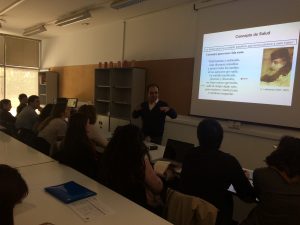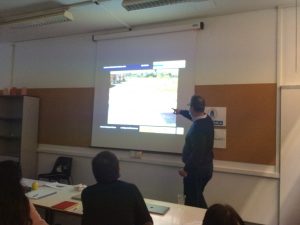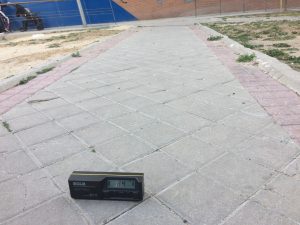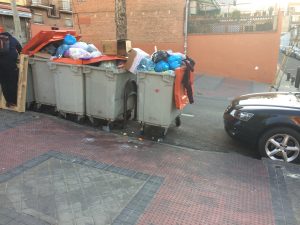Hello to everybody!!
Today we have started the morning with a very interesting talk about environmental psychology and how the places affect us once we have built the places. Professor Antonio Corraliza, from Universidad Autónoma de Madrid, explained to us the importance of the built environment not only for feeling comfortable and safe, but also to influence in our moods and behaviour. He told us several experiments and case studies that have shown how people react or behave depending on the built environment.
Also he explained some study cases to show evidence on the benefits of urban nature spaces in our physical and mental health, considering all the ages.

Professor Corraliza explaining health from the point of view of psychology.
Finally, we went by the main qualities that a space should take into consideration in order to be “age-friendly”, according to the “environmental psychogerontology” and the main problems we should think about when we work with the elderly: loneliness.
In the second part of the seminar, Carlos Rodriguez, from CEAPAT, took us across many cities and public spaces from the point of view of the elderly and handicapped people. We found out the main difficulties that the elderly face when they decide to go out to the streets. In many cities we find problems with slopes, stairs, slippery pavements, “accessible” paths in public spaces that lead to nowhere.
Other elements of the urban furniture should also be considered. For example, for a correct bank design, the height and width of the seat should be properly designed in order to consider the right ergonomy for the elderly. It is necessary that they are comfortable, but the elderly have many other requirements such as proper armrests.
The fountains and toilettes are very important for the elderly, as we have seen in previous session, they might need to go to toilet more often and be hydrated constantly, moreover during the summer.
Also, post box, garbage containers, lightning posts… they are elements that need to be considered and correctly placed in the public space in order not to disturb the pedestrian paths.

Carlos Rodriguez showing the quality of a comfortable walkable space.
Last, but not least, the importance of segregated cycling lanes. We have to remember that the pedestrian areas should be protected and assured and it is not compatible with cycling traffic when it is not leisure but urban traffic.
After the session, we went to Usera neighborhood again, in order to study again the qualities of the public space, looking through our new “glasses” of accessibility as we were in wheel chair or not being able to go up or down steps. The neighborhood has all the difficulties that we can imagine: pedestrian crossings not adapted, other ones that lead to no safe path, cars occupying the streets, even on the pedestrian areas, parks without any accessible way, trees invading and breaking the pavements… There was a big lack of continuity in pedestrian pathways.

Evidence shows the slope exceeds the accessible 2%.

At the evening, the big containers are already full. They continue to interrupt the walkable paths, the smell is nasty and unhealthy and they are located in the wrong possition to enable their easy opening.
Next session we will learn practical tools to be able to represent graphically the analysis we have developed!
Looking forward to meet you next Monday!
UNI-Health Team
